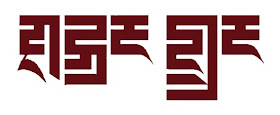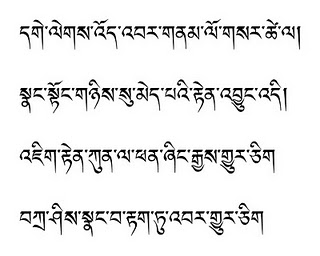ཀ་
 |
| The badge of Tsurphu monastery, the original seat of the Karmapas in Tibet, founded in 1189 by the Fist Karmapa Dusum Chenpa. |
ཀརྨ་བཀའ་བརྒྱུད།
Ka ཀ་ is the first letter of the Tibetan alphabet and the first letter of the name Karmapa ཀརྨ་པ།
But more notably; the latter ka also refers to speech, that is of the aural transmission of the Dharma though the Kagyu lineage known as the 'Golden Rosary' as one bead in a string leads to another, so are the teachings and practices passed on down through an unbroken lineage to the present day.
The Karmapa, Ogyen Trinley Dorje is the head of the Karma Kagyu lineage and the 17th in the line of Karmapa's
 |
| The 16th and 17th Karmapas. |
The above photo shows an astonishing resemblance between the 16th and 17th Karmapa of a similar age, not only in photo composition but also in location on grass next to a tent in the grounds of his seat monastery called Tsurphu in central Tibet.
It was quite by accident that these two photographs found there way together after a life-time had passed between one incarnation to another.
 |
| The 16th Karmapa Rangjung Rigpe Dorje '1924 - 1981' |
A a seldom seen and delightful photography of the 16th Karmapa, was taken by Tashi's father Peter Mannox, who documented many other of the Kagyu lineage holders during the 1970's at Rumtek monastery in Sikkim, India.
 |
| The 17th Karmapa Ogyen Trinley Dorje, born '1985 - |
 |
| Karmapa-chenno mantra, Dru-tsa script, Tashi Mannox 2022 |
As the central figure to the Kagyu linage, the mantra to ask for blessing of the Karmapa is pronounced karmapa chénno which translates as 'Karmapa here me/take heed'.
To the left is an impression of one of the Karmapa's seals, signed by the 16th Karmapa,
the hand-writing above the seal translates as
'Karma Kagyu Dharma institution'
༄། ཀརྨ་བཀའ་མརྒྱུདཆོས་སྡེ།
At the center of the seal design is the letters 'karmapa'.
 A similar seal design to the above, perhaps a copy, clearly shows the letters 'karmapa' carved into the stone seal.
A similar seal design to the above, perhaps a copy, clearly shows the letters 'karmapa' carved into the stone seal.The script style is the father to the Horyig seal script called Phags-pa.
In both seal designs, the Phags-pa letters sit on an open lotus, radiating aura lines, above the letters are three 'jewels' representing the Buddha, Dharma and Sangha, either side of which are the sun and moon.
At The top of this post is a badge of Tolung Tsuphu Monastery, there is an interesting little story to the creation of this badge of an international collaboration.
Once upon a time... In June 1996 Tashi visited Tsurphu monastery along with Akong Rinpoche and his brother Lama Yeshe Losal, to meet the young 17th Karmapa. This was a particularly special occasion, as for Lama Yeshe and Tashi, it was the first time they had seen the Karmapa since his previous incarnation.
 |
| Akong Rinpoche, Karmapa and Tsering Tashi. |
One particular day Akong Rinpoche together with Tashi organized an audience with the Karmapa. The main purpose of this meeting was to take measurements so that Tashi could make robes for the Karmapa at a later date.
Much of the day was spent in the Karmapa's private quarters where games where played with much enjoyment and laughter.
It was decided to offer Karmapa an embroidered badge, which He liked as something to give to every one of the monks in the monastery representing Tsurphu.
 |
| Drawing by Karmapa and Tashi. |
As in the Photo, all three huddled around Karmapa's seat table to plot out how the badge should look. Above is a rough sketch that was made by Tashi at the time under the instructions from both Karmapa and Akong, additional marks were added by Karmapa, such as the curls at the top as he explained the decorated surround of the Dharma wheel and swirls to the scroll. Below He added the moon and the sun and even wrote moon and sun next to them. The design session ended with how to draw a star.
Fresh in mind and sketch in hand, Tashi returned to Scotland where he requested Sherab Palden Beru a master of Tibetan art, to create a design based on Karmapa's instruction. The design at the top of this post was created by one of Sherabs students under his direction.
Tashi then contacted some Buddhist friends, Tony and Rose, he had met earlier in that year, who happened to run a badge making business in Australia called 'Badger Makes Badges'. The artwork was sent to them around the globe and being devoted to Karmapa, hundreds of beautifully embroider badges where returned to Scotland and offered to Karmapa by Akong Rinpoche on his next returning visit to Tibet.
THE END
❖
















